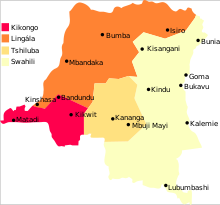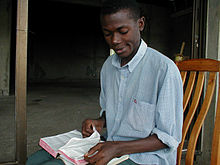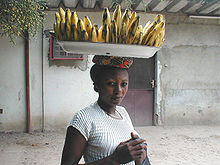
Culture of the Democratic Republic of the Congo
Background to the schools Wikipedia
SOS Children volunteers helped choose articles and made other curriculum material Click here to find out about child sponsorship.
The culture of the Democratic Republic of Congo is extremely diverse, reflecting the great diversity and different customs which exist in the country. Congolese culture has combines the influence of traditional to the region, but also has combined influences from abroad which arrived during the era of colonization and have continued to have a strong influence, without destroying the individuality of many tribes' customs.
People, language and background
Like many African countries, the borders were drawn up by colonial powers, and bore little relation to the actual spread of ethno-linguistic groups. There are around 250 languages spoken in the country, with perhaps a similar number of ethnic groups. Broadly speaking, there are four main population groups:
- Pygmies, the earliest inhabitants of the Congo, are generally hunter-gatherers who live in the forests. Expert in the ways of the forest, where they have lived for thousands of years, they live by trading meat hunted in the forest with their taller, farming neighbors in exchange for agricultural products. Increasingly, they are becoming absorbed into non-pygmy society, and adopting their languages and customs.
- Bantus arrived in the Congo in several waves from 2000 BC to 500 AD, in most part from the area in what is now southern Nigeria. They are by far the largest group, and the majority live as farmers. They are present in almost every part of the country, and their languages make up three of the five officially-recognized languages. These three languages are Kikongo, Lingala, and Tshiluba. Kikongo is spoken by the Kongo people in the far west of the country, both on the coast and inland, and was promoted by the Belgian colonial administration. Elements of Kikongo have survived amongst the descendants of slaves in the Americas—for instance, the language of the Gullah people of South Carolina contains elements of Kikongo. Lingala, spoken in the capital Kinshasa, is increasingly understood throughout the country, as the lingua franca of trade, spoken along the vast Congo river and its many tributaries. Lingala's status as the language of the national army, as well its use in the lyrics of popular Congolese music, has encouraged its adoption, and it is now the most prominent language in the country. Tshiluba (also known as Chiluba and Luba-Kasai) is spoken in the southeastern Kasai regions.
- East Africans brought in the fourth of the official languages, Kingwana — a Congolese dialect of Swahili. Note that the fifth language, French, is the official language of government, a result of Congo's colonial relationship with Belgium. The East Africans are related to the Bantus mentioned above, but tend to differ in their way of life, in that they practice herding as well as farming. They came from the various countries to the east of Congo: Rwanda, Uganda, Burundi and Tanzania, bringing with them many of the ethnic rivalries that have inflamed recent conflicts.
- The northeast of the country includes groups who originally come from Darfur in southern Sudan and Ethiopia. In general these are pastoral cattle raisers and include the Tutsi, possibly the tallest people in the world. These North Eastern peoples also migrated into the Rwanda and Burundi around the same time often mixing with the Eastern African groups.
The above descriptions are by necessity simplified. Many Congolese are multilingual, and the language used depends on the context. For instance, a government official might use French to set a tone of formality and authority with another official, use Lingala when buying goods at a market, and the local language when in his home village. English is also spoken, especially in the east where eastern and southern African influences have spread in the post-Mobutu era. Among the slangs spoken in Congo, Indubil has been noted since around the 1960s, and continues to evolve nowadays.
Mixed marriages between ethnic groups are common, particularly in urban areas where many different groups live side by side. Europeans appear in small numbers throughout the country, as missionaries in the countryside, and as businessmen and traders in the cities. Also acting as merchants are small numbers of Lebanese and Pakistanis.
More information on the various peoples in Congo can be found in the Early Congolese History article.
Religion and belief
The main religions in the DRC are:
- Indigenous traditional beliefs: 11.5%
- Catholic Christianity: 50%
- Protestant Christianity: 20%
- Indigenous Christianity: 13.5%, nearly all of whom (13%) are followers of Kimbanguism.
- Other Christian denominations: 1%
- Islam: 1.5%
There are small communities of Jews and Hindus who work in commercial urban areas. Atheism is very rare.
Indigenous traditional beliefs
Though only 11.5 per cent of Congolese exclusively follow indigenous beliefs, these traditional belief systems are often intermingled with forms of Christianity, and are familiar to the majority of Congolese. Throughout the DRC the beliefs take on a number of forms, but they have a number of things in common:
- A creator spirit is thought to be sovereign of the spirit world, but this god is rarely the direct cause of events. In many Congolese languages, the name of the creator god derives from the word father or maker. Some groups regard the creator as being omnipresent, whilst others believe the god lives in the sky. For most believers in indigenous religions, contact with the creator god is made via ancestor spirits. A smaller number of groups believe that individuals can have direct contact.
- A belief in an essential life-force in which animates the body.The force is thought to leave the body upon the un known* Nature spirits, worshiped mainly in forested regions, are often the embodiment of particular locations such as whirlpools, springs and mountains. The afterlife is believed to exist underground, retards especially under lakes, where ghostly replicas of Congolese villages reside.
- Diviners, witches, dream interpreters and healers act as conduits for supernatural forces.
- Ceremonies and collective prayers—to ancestors, nature spirits and the creator god—are generally performed at particular locations such as sacred trees, grottoes or crossroads. These ceremonies usually take place at a specific time of day. The location and times vary according to the ethnic group.
Belief in ] is common, and sometimes intersects with the more fundamentalist and evangelical versions of Christianity. In recent years, these beliefs have gained adherents in urban areas, whereas before they were mainly confined to the countryside. The increasing beliefs in witches and sorcery have tended to mirror the social decay caused by war and poverty. Many of the street children that roam the Congo's cities have been cast out of their families after being denounced as witches. These homeless 'witch children' often live in cemeteries and only come out at night, and follow occult practices. See BBC News article on Kinshasa's street children. For comparison, see article on beliefs of Miami street children.
Catholic and Protestant Christianity
Christianity has a long history in Congo, dating back to 1484, when the Portuguese arrived and convinced the king and entourage of the Kongo people to convert. In 1506, a Portuguese-supported candidate for kingship, Alfonso I of Kongo won the throne. Alfonso (the Kongo royal family had begun to take on Portuguese names), established relations with the Vatican. More widespread conversion occurred during the Belgian colonial era. Christianity varies in its forms, and is in some ways surprisingly similar to native beliefs.
During the colonial period, a European-style Christianity was at first promoted by the authorities. Native Congolese generally attended different churches or services from whites. If they worshiped under the same roof, the native Congolese sat on benches at the back, while the whites sat in chairs at the front. Towards the end of the colonial era, more African elements were incorporated into Christianity, including songs and dances which were formerly condemned as pagan. Eventually, even native fables and myths were appropriated and merged into Congolese Christianity, in a similar process to that which occurred with Christianity in Europe.
Recent developments include the increasing popularity of the "Gospel of Prosperity" – a form of Christianity in which the emphasis is on wealth acquisition and born-again Christianity. Adherents are led to believe that instant wealth and magical prosperity will result from giving tithes to their charismatic preacher. The leaders often draw on the techniques of American televangelists, and the message is appealing to those living in extreme poverty.
Kimbanguism
In the first half on the 20th century, prophetic movements sprang up. Their nature was both anti-colonial and Christian, and led to a rigorous crackdown by the authorities.
Simon Kimbangu was the prophet of largest of these movements. He was born in a village near Kinshasa, raised and educated by a Protestant Christian mission and trained to become a priest. In April 1921, at the age of 39, he reportedly had a religious vision of Jesus Christ, who called on him to reconvert his people and dedicate his life to Christ. Kimbangu chose to try to ignore the vision, and fled to Kinshasa where he abandoned his life as a priest and took to menial work. More visions came, and eventually he heeded the calling and returned to his home village and started to devote his life to Christ. Soon after, he is reported to have healed a sick woman by laying his hands on her. Dozens of apparent miracles were subsequently performed by Kimbangu, and he gained followers from surrounding villages and towns. The official Catholic organizations protested to the authorities, and the Protestant church abandoned him. The economic effects of Kimbangu's ministry were being felt, with thousands of Congolese leaving their work to listen to Kimbangu speak. In June the Belgians arrested him for inciting revolution and civil disobedience. Four months later he was sentenced to death. After an international outcry, Albert I of Belgium commuted the sentence to life impisonment. He died 30 years later in prison, in 1951.
Colonial authorities assumed his movement would wither after his imprisonment and death, but the church continued to flourish underground, and was an effective weapon in the fight against colonialism. In the post-colonial era, its record has been more mixed. Instead of banning the church, Mobutu used a far more effective method of neutralizing it: namely co-opting the church and giving it an official status. Kimbanguism has now spread across the country, and now has branches in nine of the surrounding countries, making it the most popular "native" form of Christianity in Africa. Followers do not smoke, drink alcohol and abhor violence. Monogamy is practiced.
Religion today
Article 22 of the constitution allows for religious freedom. These rights are generally respected by the government. Religious tension exists in some areas because of the link between prophetic groups and paramilitary organizations. In the turbulent eastern region, where the Second Congo War still simmers, some guerrilla groups have a major religious element, believing for instance that they are able to turn enemy bullets into water by wearing certain fetishes.
Cusine
Only 2.86% of the land is cultivated, and most of this is used for subsistence farming. People gather wild fruit, mushrooms, and honey, as well as hunt and fish. They will often sell these crops at markets or by the roadside. Cattle breeding and the development of large-scale agricultural businesses has been hindered by the recent war and the poor quality of the road system.
Congo's farmland is the source of a wide variety of crops. These include maize, rice, cassava (manioc), sweet potato, yam, taro, plantain, tomato, pumpkin and varieties of peas and nuts. These foods are eaten throughout the country, but there are also regional dishes. The most important crops for export are coffee and palm oil.
Music
Congolese musicians, like Le Grand Kallé, were extremely influential in pioneering the musical style of "African Rumba"', a blend of South American and traditional African musical styles, more often known as Soukous in the years leading up to the independence of the Belgian Congo. Congolese musicians were supported by the Mobutu regime in Zaire during the Cold War, and musicians like Pépé Kallé became incredible popular in the international francophone market into the 1990s.
Cinema
In the years following independence, the nascent Congolese film industry was held up by many years of war. However, the first Congolese feature film ( La Vie est Belle by the celebrated director Mwezé Ngangura) was released in 1987. In recent years, Congolese cinema has reached a wider audience, though the growth of the industry is restricted by the small profits which directors can make (owing to pirating) and rarity of credit.
Zairese/Congolese writers
- Léonie Abo, (1945–)
- Raïs Neza Boneza (1979–)
- Amba Bongo
- Lima-Baleka Bosekilolo
- Maguy Kabamba (1960–)
- Christine Kalonji
- V.Y. Mudimbe (1941–)
- Kavidi Wivine N'Landu
- Clémentine Nzuji (1944–)
- Sony Labou Tansi (1947–1995)
- Kabika Tshilolo
- Frederick Kambemba Yamusangie
- Lye M Yoka
Visual art
The Congolese are known for their art. Traditional art includes masks, wooden statues, art of the Kuba Kingdom, textiles and woven arts. Notable contemporary artists are Chéri Samba or Bodys Isek Kingelez. The best known artists successful inside and outside the country are Lema Kusa (painting), Alfred Liyolo (sculpture), Roger Botembe (painting), Nshole (painting), Henri Kalama Akulez (painting), Mavinga (painting), Freddy Tsimba (sculpture), Claudy Khan (painting). Some are teaching at the Académie de Beaux-Arts de Kinshasa, which is the only arts academy of a university level in Central Africa.




